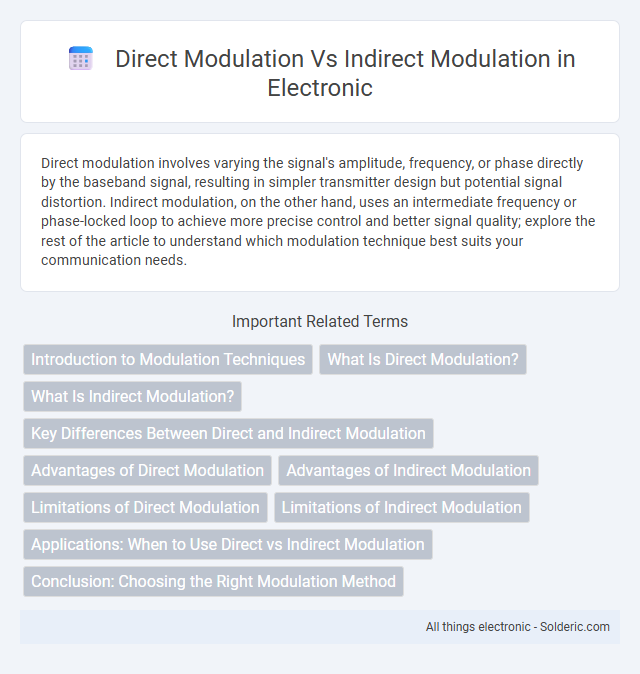Direct modulation involves varying the signal's amplitude, frequency, or phase directly by the baseband signal, resulting in simpler transmitter design but potential signal distortion. Indirect modulation, on the other hand, uses an intermediate frequency or phase-locked loop to achieve more precise control and better signal quality; explore the rest of the article to understand which modulation technique best suits your communication needs.
Comparison Table
| Aspect | Direct Modulation | Indirect Modulation |
|---|---|---|
| Definition | Direct control of the signal's amplitude, frequency, or phase by the baseband signal. | Modulation through an intermediate carrier or stage before final signal transmission. |
| Complexity | Simple design, fewer components. | More complex due to additional stages or mixers. |
| Signal Quality | Prone to distortions and nonlinearities. | Better signal purity and stability. |
| Frequency Accuracy | Lower accuracy, more frequency drift. | High frequency stability with phase-locked loops. |
| Applications | Low-cost radio transmitters, simple communication devices. | High-performance communication systems, radar, satellite. |
| Power Efficiency | Generally less efficient due to direct signal alteration. | Higher efficiency due to controlled modulation stages. |
Introduction to Modulation Techniques
Direct modulation involves varying the carrier signal's amplitude, frequency, or phase directly with the input signal, making it simpler and more cost-effective for transmitting information. Indirect modulation, or superheterodyne modulation, uses an intermediate frequency to first modulate a baseband signal before converting it to the carrier frequency, offering greater stability and improved signal quality. Your choice between these techniques depends on system requirements such as complexity, bandwidth, and performance in noisy environments.
What Is Direct Modulation?
Direct modulation involves varying the frequency, phase, or amplitude of the carrier signal by directly altering the properties of the transmitter's oscillator or laser, resulting in signal changes at the source. This technique is commonly used in optical communication systems where the laser diode's current is adjusted to encode data, offering simplicity and reduced component count. Limitations include increased chirp and spectral broadening, which can impact signal integrity over long distances compared to indirect modulation methods.
What Is Indirect Modulation?
Indirect modulation is a communication technique where the information signal first modulates a high-frequency carrier through an intermediate frequency or subcarrier, rather than directly altering the carrier wave. This method often involves frequency or phase modulation of the intermediate signal, enhancing transmission stability and reducing distortion, especially in high-frequency applications. Indirect modulation is commonly implemented in radio transmitters to achieve precise frequency control and improved signal quality.
Key Differences Between Direct and Indirect Modulation
Direct modulation involves varying the laser diode's injection current to directly change the output light intensity, resulting in a simpler and more compact system but potential signal distortion due to chirp and limited bandwidth. Indirect modulation, also known as external modulation, uses an external electro-optic or acousto-optic modulator to control the laser beam intensity or phase, providing higher signal quality, reduced chirp, and greater modulation bandwidth at the expense of increased system complexity and cost. Key differences include modulation speed, signal integrity, complexity, and susceptibility to nonlinear effects.
Advantages of Direct Modulation
Direct modulation offers advantages such as simplified transmitter design and reduced cost by directly varying the laser's drive current to encode data. This approach enables faster modulation speeds and lower power consumption compared to indirect modulation methods that rely on external modulators. Your system benefits from enhanced integration and compactness, making direct modulation ideal for high-performance optical communication applications.
Advantages of Indirect Modulation
Indirect modulation offers improved spectral purity and reduced phase noise compared to direct modulation, making it ideal for high-frequency and long-distance communication. It allows precise control over frequency and phase, enhancing signal stability and minimizing distortion in complex transmission environments. If your system requires high signal fidelity and robust performance, indirect modulation provides significant advantages over direct modulation.
Limitations of Direct Modulation
Direct modulation is limited by signal distortion and reduced bandwidth due to chirp effects, which degrade overall system performance. It struggles with high-frequency applications because the laser's output wavelength fluctuates with injection current changes. Your optical communication system may experience instability and increased noise, restricting long-distance transmission capabilities.
Limitations of Indirect Modulation
Indirect modulation faces limitations such as increased system complexity and higher power consumption due to the presence of extra components like voltage-controlled oscillators and phase-locked loops. Signal distortion and phase noise are more prominent, reducing overall communication quality and reliability. Your choice of modulation technique should consider these trade-offs to optimize performance in specific applications.
Applications: When to Use Direct vs Indirect Modulation
Direct modulation is ideal for simple, low-cost communication systems such as short-range wireless devices and low-frequency radios where minimal circuit complexity is required. Indirect modulation suits high-frequency, high-precision applications like satellite communication, radar systems, and microwave transmitters due to its superior frequency stability and reduced phase noise. Choosing direct or indirect modulation depends on factors like operating frequency, signal purity requirements, and system cost constraints.
Conclusion: Choosing the Right Modulation Method
Direct modulation offers simplicity and cost-effectiveness by integrating the modulation process within the laser source, making it ideal for short-reach and low-cost applications. Indirect modulation, utilizing external modulators like Mach-Zehnder interferometers, provides superior signal quality and higher bandwidth, crucial for long-haul and high-performance communication systems. Your optimal choice depends on balancing system requirements such as distance, data rate, and budget constraints to ensure efficient and reliable optical transmission.
direct modulation vs indirect modulation Infographic

 solderic.com
solderic.com